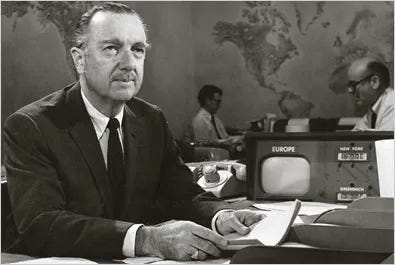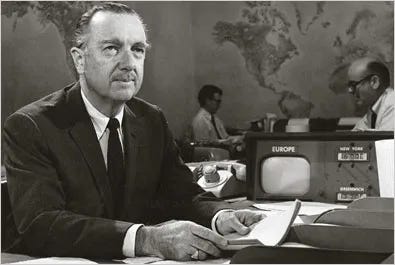Remember when the news wasn’t just another form of entertainment, networks weren’t about cranking up the crazy to divide people, and reporters weren’t vying for celebrity status?
Once upon a time, the mid-1950s to the mid-1970s ~ let’s call it the "Golden Age of Journalism" ~ figures the likes of Douglas Edwards, Walter Cronkite, Edward R. Murrow, Dan Rather, Chet Huntley, David Brinkley, and Howard K. Smith reported, inquired, and investigated. They were the credible gatekeepers of truth. Their job was to safeguard the public interest, give us the facts, and cultivate a more balanced national conversation. Their work was untainted by the sensationalism that now saturates today's media.
So, what changed? How did we go from trustworthy journalism to the circus we see today, where we’re not even living in the same reality…where the media landscape is fragmented, partisan, and skewed?
A key turning point was the quiet disappearance of the Federal Communications Commission’s Fairness Doctrine in 1987.
Introduced by the FCC in 1949, the Fairness Doctrine required broadcasters to present controversial issues of public importance in a fair and balanced manner. If a station aired one-sided political views, it had to provide time for opposing perspectives. Because the airwaves were deemed to be a public resource, the goals were clear: to promote an informed citizenry, not echo chambers; to prevent the monopolization of public discourse; to expose viewers to a diversity of perspectives; and to encourage critical thinking.
That was the premise…and, it was a good and noble one. And, it was presented at a time when, as Paul Steiger, the founder of ProPublica, noted, journalism was being enhanced by advances in technology, which, in turn, enhanced the opportunities for more aggressive investigative reporting…and that, in turn, enhanced people’s consciousness about the realities of the world around them. Live broadcasts of events like the Civil Rights Movement, the Vietnam War, and the Watergate scandal brought critical issues to the public. Dramatic images of injustice and groundbreaking investigations, like the release of the Pentagon Papers, showed journalism’s power to shape public opinion and hold authority accountable. These were the moments when journalism held up a mirror to society and made us look at some ugly truths.
Today, that media environment feels distant. Too much of the media caters to and tailors their news to specific audiences with the intent of reinforcing pre-existing beliefs.
The result? We’re not just divided by ideology but by information itself.
This isn’t to say that today’s media landscape is devoid of value. While we’ve certainly lost the shared understanding and balance that the Fairness Doctrine fostered, we do have a more diverse array of platforms for in-depth investigative journalism. Programs like Frontline, 60 Minutes, or organizations like ProPublica continue to provide high-quality, fact-based reporting. These outlets offer a vital public service by investigating stories that hold powerful institutions accountable and inform the public on critical issues. Yet, these are pockets of excellence in a much more fragmented and polarized ecosystem.
The Fairness Doctrine was not without its critics. Supporters saw it as essential to democracy, preventing broadcasters from turning the airwaves into partisan soapboxes. Opponents argued that it infringed on First Amendment rights, compelling stations to air perspectives they didn’t support. By the 1980s, as cable TV and other media platforms rose, critics claimed that the Doctrine had become unnecessary.
And so, in 1987, the Reagan administration abolished the Fairness Doctrine, citing the growing diversity of media outlets as reason enough. In hindsight, that rationale seems flawed.
In losing the Fairness Doctrine, we lost something essential to democracy: a shared understanding of reality. While we now have more media sources than ever ~ from blogs to podcasts ~ this abundance hasn’t enriched the marketplace of ideas. Instead, we’ve witnessed the rise of misinformation and disinformation, with public discourse splintering into ever-narrower factions. It’s easier than ever to retreat into ideological media bubbles, sipping at one’s preferred versions of reality.
Cable news, free from traditional broadcast regulations, has become the king of that bubble. No more balance. No more fairness. Just a 24/7 feed of your own biases getting spoon-fed back to you with a side of outrage…platforms for sensationalism and partisanship.
Here’s where things get even trickier. Today, media outlets have taken the idea of fairness and twisted it. In the name of giving both sides a voice, they’re giving platforms to toxic or harmful ideas and allowing for false equivalences. Look, free speech is important, but not all ideas deserve equal airtime or deserve equal weight. Elevating conspiracy theories or hate speech under the banner of balance is dangerous. And it’s happening all the time. This false balance elevates discriminatory, anti-democratic, or violent ideologies, distorting the public discourse. Responsible journalism should recognize the danger in amplifying such rhetoric and avoid presenting extreme viewpoints as equally valid.
The bottom line: It’s hard not to feel a sense of loss for a time when journalists operated within a doctrine that prioritized truth, fairness, and integrity ~ principles now largely overshadowed by clicks and outrage.
The Fairness Doctrine may be gone. But, as we navigate today’s fragmented media landscape, is there any conceivable way to restore what we’ve lost?
Or, is it just too late? (Consider that the last attempt to revive the Doctrine ended in 1991 when President Bush to veto it.).
Is the cat so far out of the bag that all we can do is enjoy the memory?





Yes, I am aware that Reagan removed the Fairness Doctrine during his watch. What a disgrace. I did not know that Bush Sr had a chance to revive it in 1991. And then because of its lack, in 1996 Rupert Murdoch was able to launch Fox here in the United States, after his primitively diabolical idea of one sided propaganda masquerading as "news" was rejected by his own native Australia. While other media outlets share the shame with Fox since then for emulating profit while promoting lack of valor in business, the decline of critical thinking skills in our current voting population is both a result of their madness and a reason for its propagation. I think we have the stronger hand, though. Notice how the liars whimper and grovel more and more lately? Keep marching.
Excellent! Unfortunately, the cat is not only out of the bag, it is in heaven with Walter. and Doug.